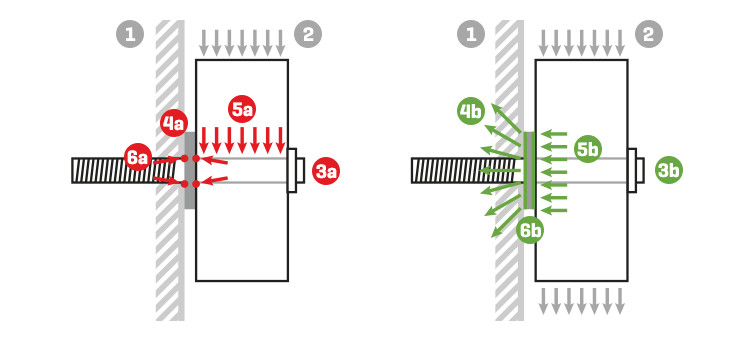Applying exactly the right amount of torque is important to ensure proper clamping between the engine block and the tensioners or idler pulleys, for instance. A lot of mechanics feel confident to fasten bolts and nuts without using a torque wrench, yet experiments have shown that the vast majority of them fail to get the amount of torque more or less right. And the consequences of applying too much or too little torque can be dire, as we’ll discuss below.
The consequences of excessive or insufficient torque
Insufficient torque
Engines that are running, tend to vibrate. When you apply exactly the right amount of fastening force, you can rest assured that the bolt will transfer the ‘hits’ as well as the load of the belt to the bulk of the engine, which will absorb them. In the case of insufficient torque, it’s the stud or the bolt itself that suffers all the impact, causing it to shear. Alternatively, the engine’s vibrations can cause the bolt or nut to come undone, displacing the tensioner. This, in turn, will lead to incorrect belt tension and, eventually, to belt and/or engine damage.

The pulley on the left is mounted to the engine block (1) with insufficient torque (3a) creating a low clamping load (4a) between the pulley mounting and the engine block. The load from the belt (2) is transferred directly unto the shank of the bolt (5a), creating a shearing effect causing the bolt to fail (6a). The pulley on the right is mounted to the engine block (1) with the proper amount of torque (3b), creating the correct clamping load (4b). The load from the belt (2) is transferred into the engine block and not just the shank of the bolt (5b); eliminating any shearing effect (6b).
Excessive torque
Yet too much torque is equally harmful, damaging the nylon or plastic within some tensioners or idler pulleys, as well as the bearing, or damaging the screw thread of the bolt or nut in question. Moreover, if this happens with for instance an aluminum cylinder head, the screw thread in the aluminum engine block will be permanently damaged, and it will be impossible to attain the correct clamping load again afterwards.
A note on narrow space
It should be clear by now that following the torque specs to the letter – and using a torque wrench – does matter. Is the space quite narrow? A special torque wrench will seal the deal. Also, note that not all M8 or M10 bolts require the same amount of torque!
Special torque settings
While tightening a nut/bolt, applying the prescribed torque value in Nm only does not guarantee that the desired clamping force will be reached; since tests have shown that quite big differences in clamping can occur. That is why many present-day manuals recommend using a torque angle as well, on top of a torque value (e.g. 20Nm + 45°). This guarantees a much more accurate result. In addition, there are special cases in which the manual will instruct you to apply torque, wait a few moments, apply torque again, wait some more (and so on), to give the nut or bolt time to settle – or in other words: to ensure the desired amount of clamping. Also, 45Nm + 45° + 45° is not the same as 45Nm + 90° for instance. Between the two 45° turns, the bolt will ‘settle’.
A piece of advice on using Loctite
To prevent accidental loosening, a lot of nuts and bolts are secured with Loctite. Yet watch out with the use of this adhesive in a blind hole: applying Loctite to a bolt may seal off its threads, which means the air in the blind hole cannot escape when you screw the bolt in. The compressed air in the hole may distort your reading of the amount of torque you have applied (e.g. 20 Nm while in reality the number is lower). That’s why we advise you to apply the glue towards the bottom of the blind hole rather than to the bolt itself. Naturally, you should make sure that the bolt actually comes into contact with the glue.